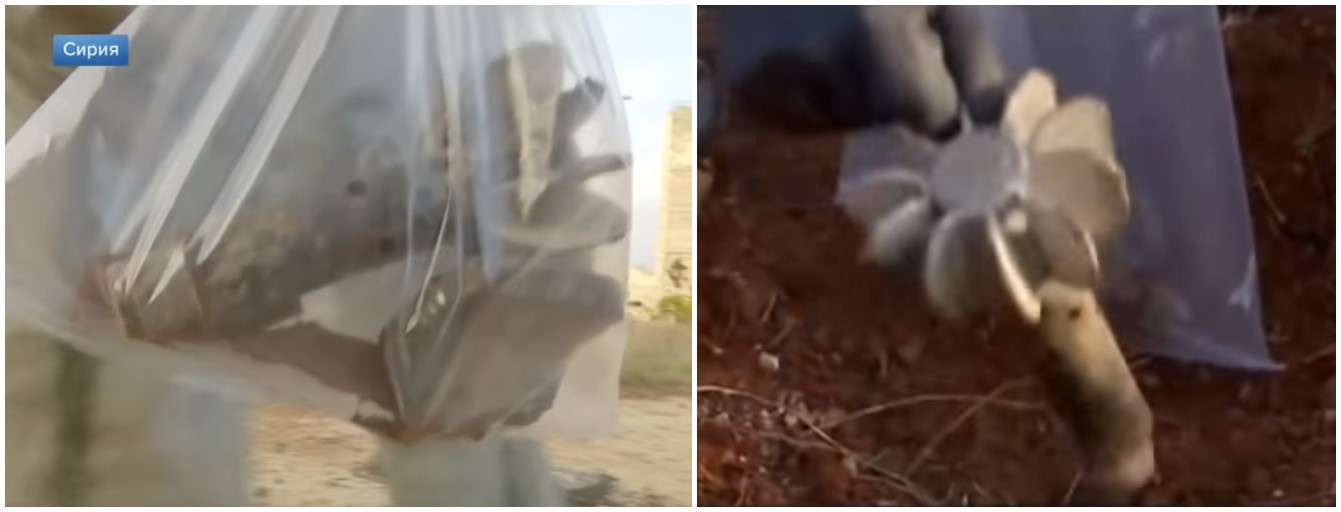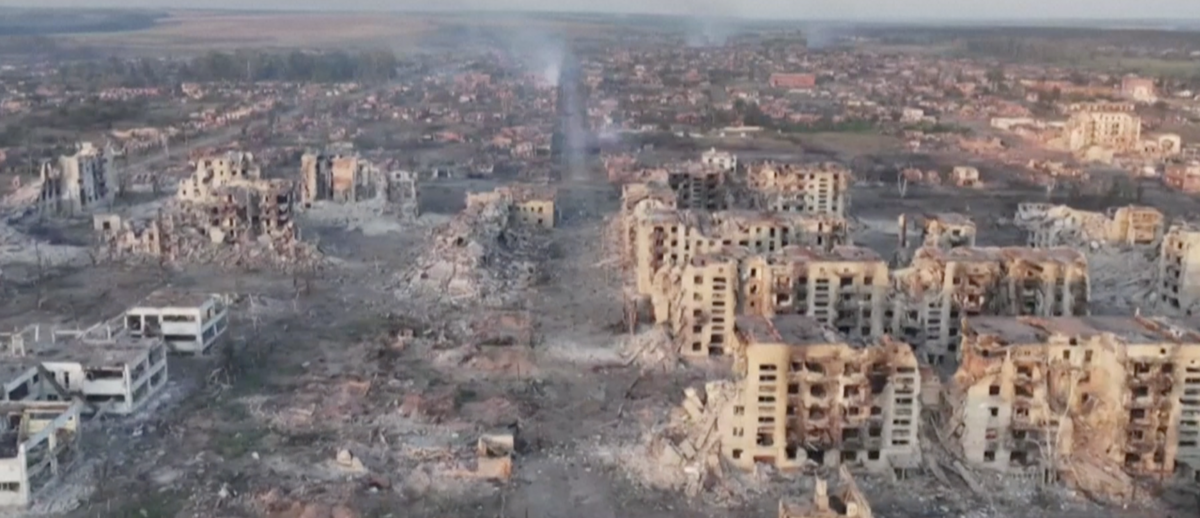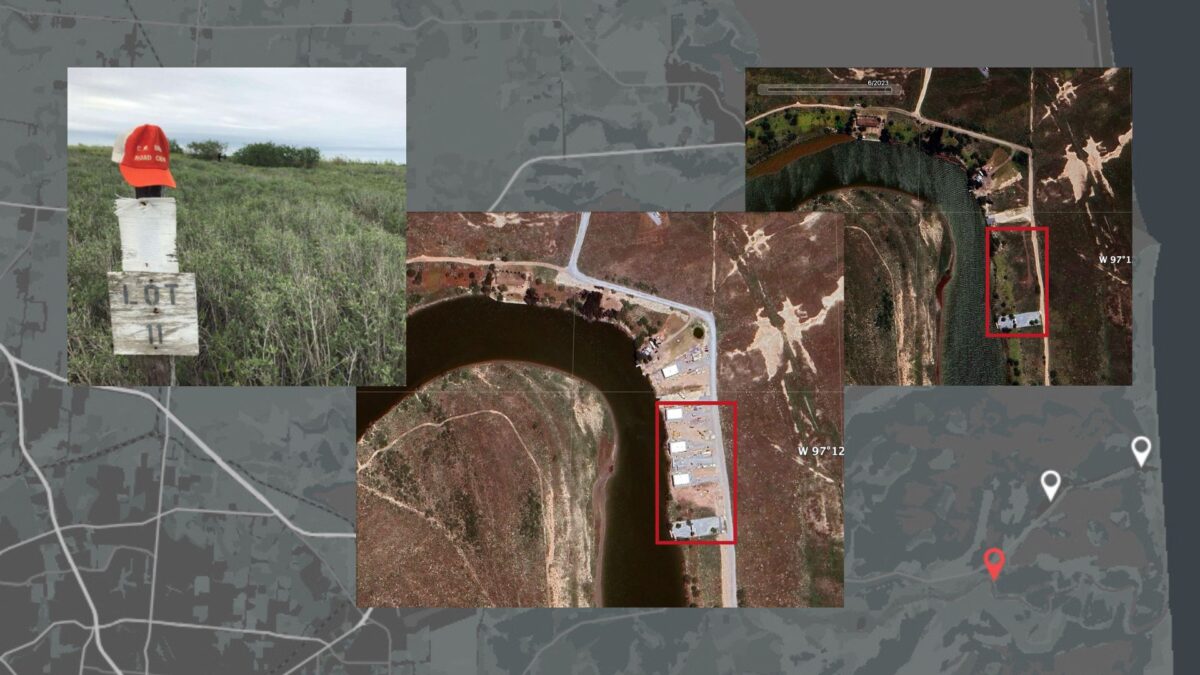Open Source Survey of the Alleged November 24 2018 Chemical Attack in Aleppo
Introduction
On the evening of November 24 of this year, a large number of people were admitted to hospitals in Aleppo complaining of difficulty breathing. Initial reports, such as this archived article from Sputnik, stated that there had been multiple fatalities. However, these reports were then revised, detailing only injuries as a result of the incident. The Syrian government and the Russian Ministry of Defense blamed rebel forces, while the rebels denied launching this specific attack or of using any kind of chemical warfare agents. This article will examine the available open source information associated with this event.
Allegations & Statements
Government & Russia
The Russian military stated that at 2150 on November 24 2018 “terrorist groups” had fired 120mm mortars at neighbourhoods in the north-west of Aleppo, which landed in the vicinity of Nile Street. These mortars were allegedly fired from a location near the village of “al-Buraykat” in the demilitarised zone, a buffer zone between rebel and government forces. The Russian military also claimed that these shells had most likely been filled with chlorine based on the symptoms of those affected. The location of “al-Buraykat” appears to be an area just south-west of Mansoura. Although it does not show up on any commercial maps, it does show up on a weather mapping application and was confirmed by Syrians familiar with the area contacted by Bellingcat. There does not seem to be any other location with this name near the city of Aleppo.
Russia later stated they had destroyed the group which launched this attack, releasing footage of a strike to support their statement. This footage could be geolocated to a position south of Aleppo in rebel-held territory. The footage of the strike shown below is colour corrected:
Syrian Observatory for Human Rights
The Syrian Observatory for Human Rights (SOHR) reported that the total number of people hospitalized due to the attack was 94 and of those that were hospitalized due to the attack, 31 remained under care and observation due to their condition being unstable.
SOHR also reported that a large number of victims were women and children, consistent with reporting by government media, and also consistent with reports of a populated residential area being attacked.
Rebels
A number of rebel groups denied knowledge or involvement in the alleged attack, while the opposition media STEP Agency published an article casting doubt on the narrative that there had been a chemical attack.
Opposition news media reported that the Zahra operations room denied using any chlorine or chemicals in attacks against government held area.
The spokesman for Nour al-Dien al-Zenki denied claims made by the Syrian government that rebels were the ones who committed the attack, instead blaming the attack on Russia and government forces.
The deputy commander for Jaish Tahrir al-Sham went as far as to accuse the Syrian government of possibly orchestrating the attack with the cooperation Hezbollah and intelligence forces under Maher Assad, who allegedly brought in chemicals through Qalamoun. Leadership of Fastaqem Union, a faction that largely merged with Ahrar al-Sham in 2017 and now part of the Syrian National Army, also blamed pro-government forces.
Yassir Abdel-Rahim, head of Faylaq al-Sham and a representative at the Astana negotiations, also blamed the government for the attacks. Mustafa Sejari, former head of the political committee of Moutasim Brigade, also claimed that blaming the attack on the opposition was meant to undermine the negotiations at Sochi.
Available media
Currently available media include multiple videos from hospitals, including Al Razi and Aleppo University hospital. These were taken by both activists and by state media organisations. There are also videos showing a Russian CBRN team visiting one of the sites of the attacks and taking samples, as well as the video of a Russian retaliatory strike. No media appears to have been posted depicting the attack itself or casualties at any other location than at hospitals
The first recorded images of the location of the alleged attack were published by SANA news. They showed the roof of a house, including solar water-heating cells which had clearly been damaged. There was still a significant amount of water on the roof in the vicinity of the damaged solar cells, indicating the damage was recent. Fragmentation marks on the walls of the roof, including through the satellite dish, also indicated that some kind of explosion had likely caused this damage.
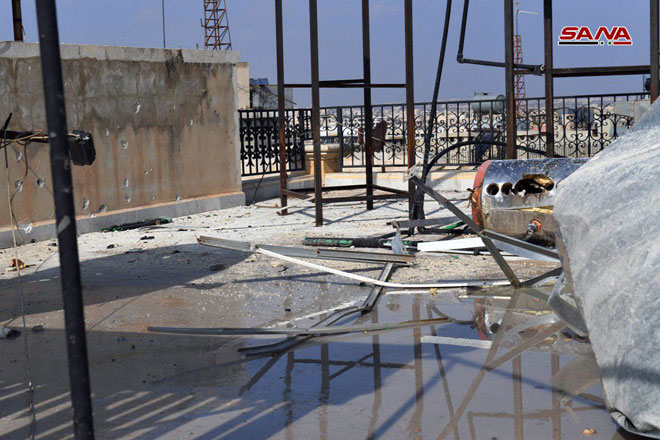
Fragmentation marks and water (source)
The set of images published by SANA also showed a 120mm mortar bomb stem, presumably in the same area as the roof with the solar cells on its roof. This image can be geolocated to a location just to the north of Nile Street, which is consistent with Russian and Syrian government statements.
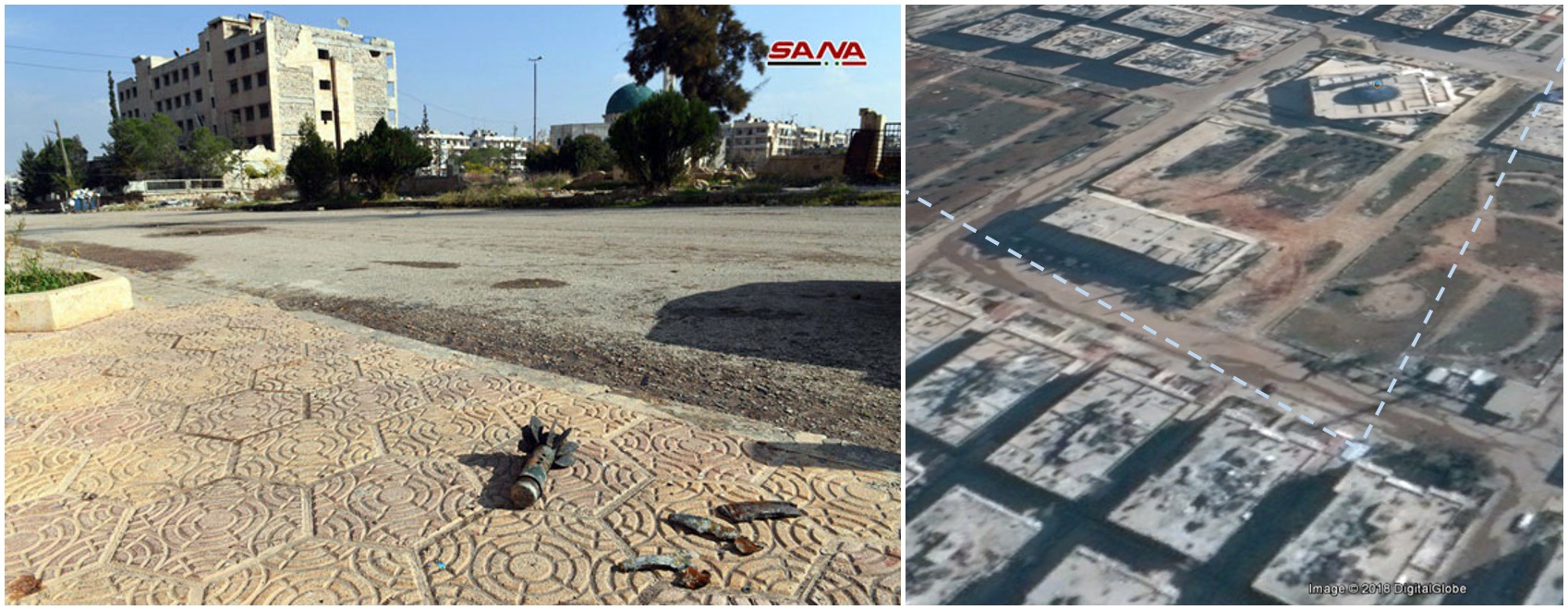
Viewpoint of SANA image (source)
This is next to the location that the Russian CBRN team later visited and took samples from, including retrieving pieces of what appeared to be a 120mm mortar.

CBRN team geolocation (source)
Locations
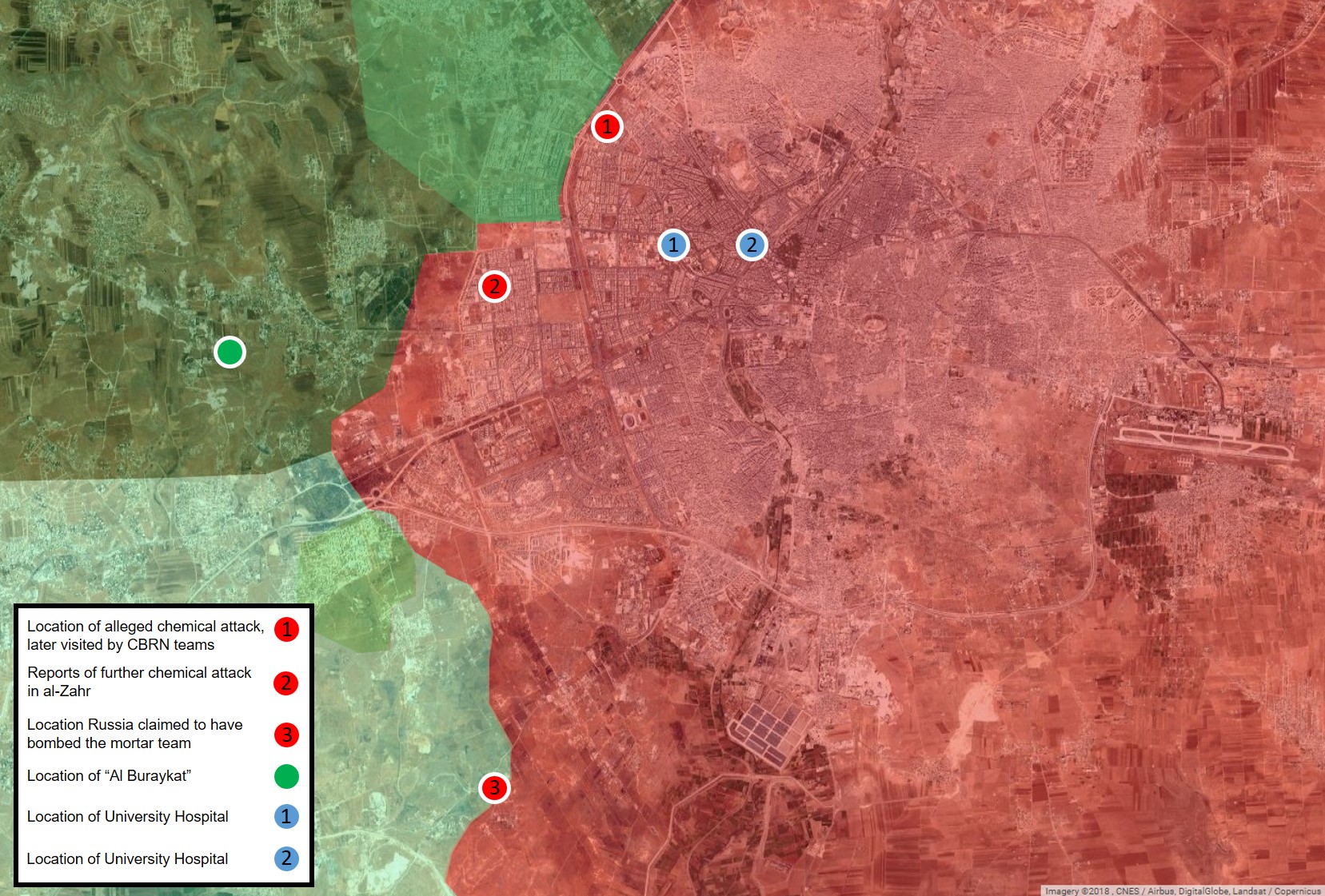
Map showing key locations and frontline positions (source)
Munitions
At the time of writing the only munitions associated with this event are 120mm mortars. A Russian military statement named 120mm mortars as the weapons used in the early morning of the 25th November. Both the images from SANA and videos showing the Russian CBRN unit depicted 120mm mortar stems.
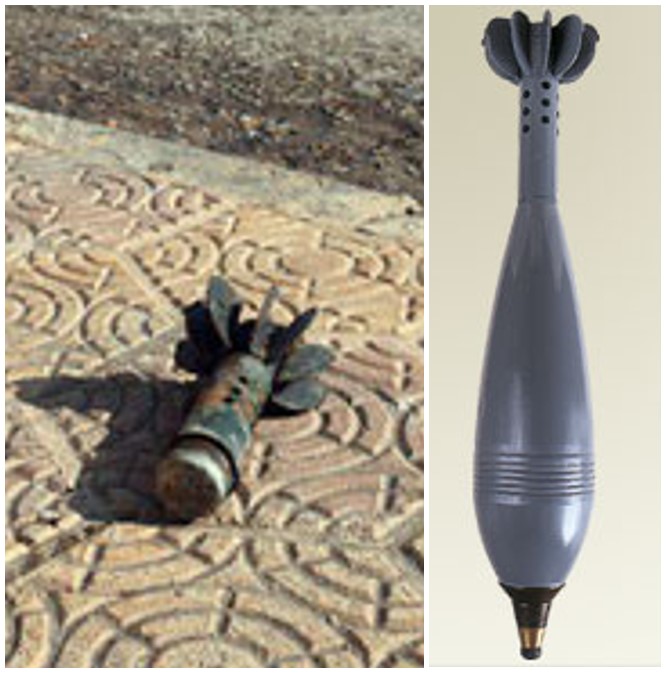
120mm mortar stem photographed at the attack site compared to a complete 120mm mortar (left: source, right: source)
The Syrian conflict has seen significant use of chemical weapons, and we have identified multiple variations of munitions specialised in carrying chemical warfare agents, including chlorine.
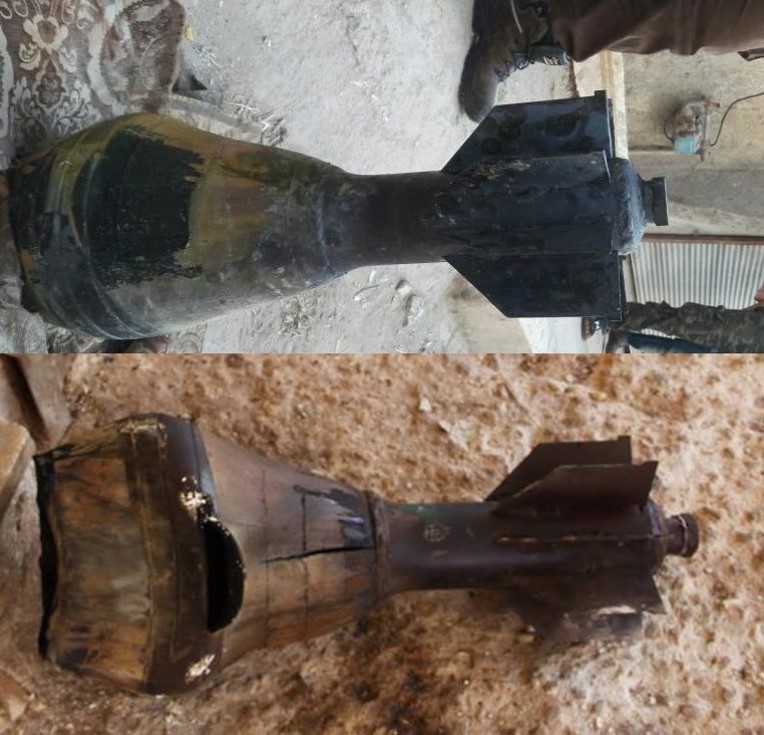
Islamic State sulphur mustard munitions (source)
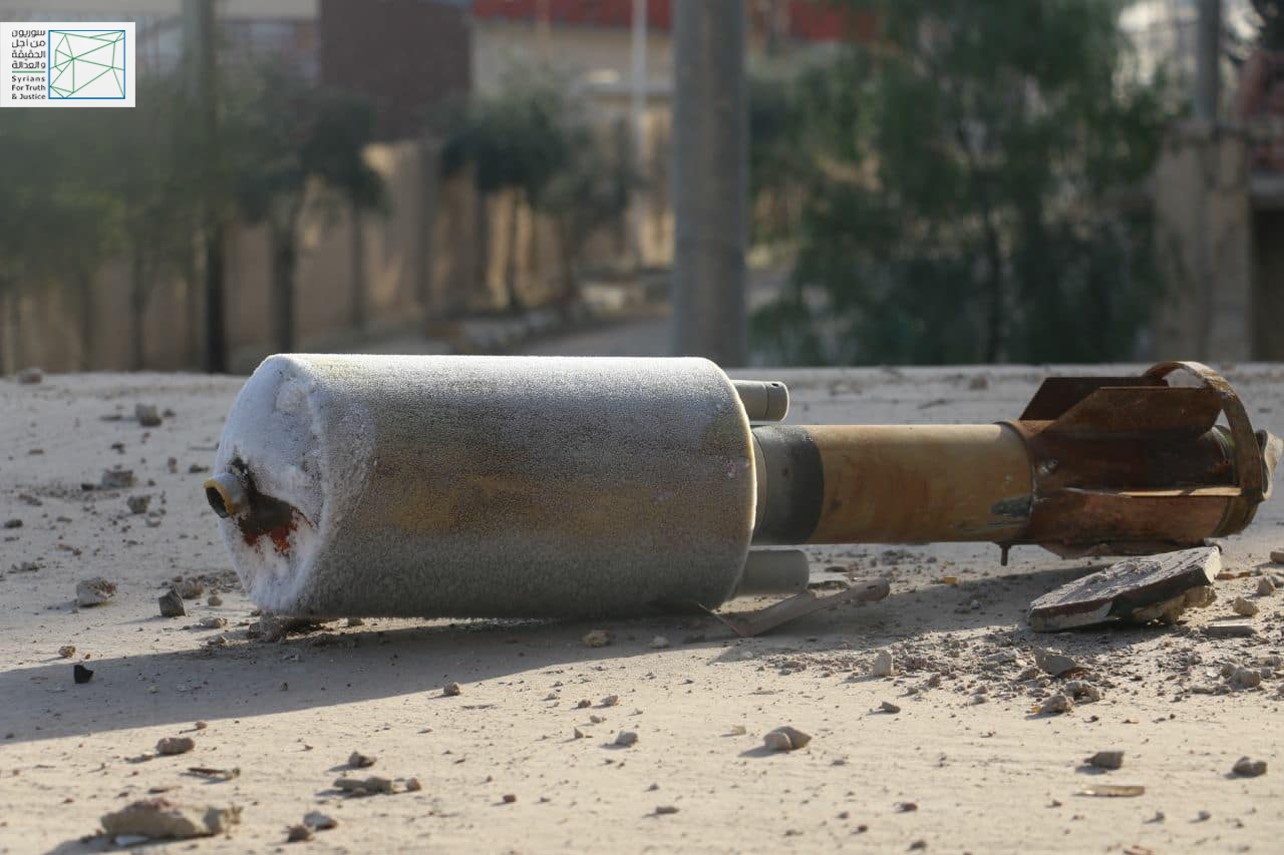
Pro-Syrian government chlorine rockets, with a 107mm rocket motor (source)
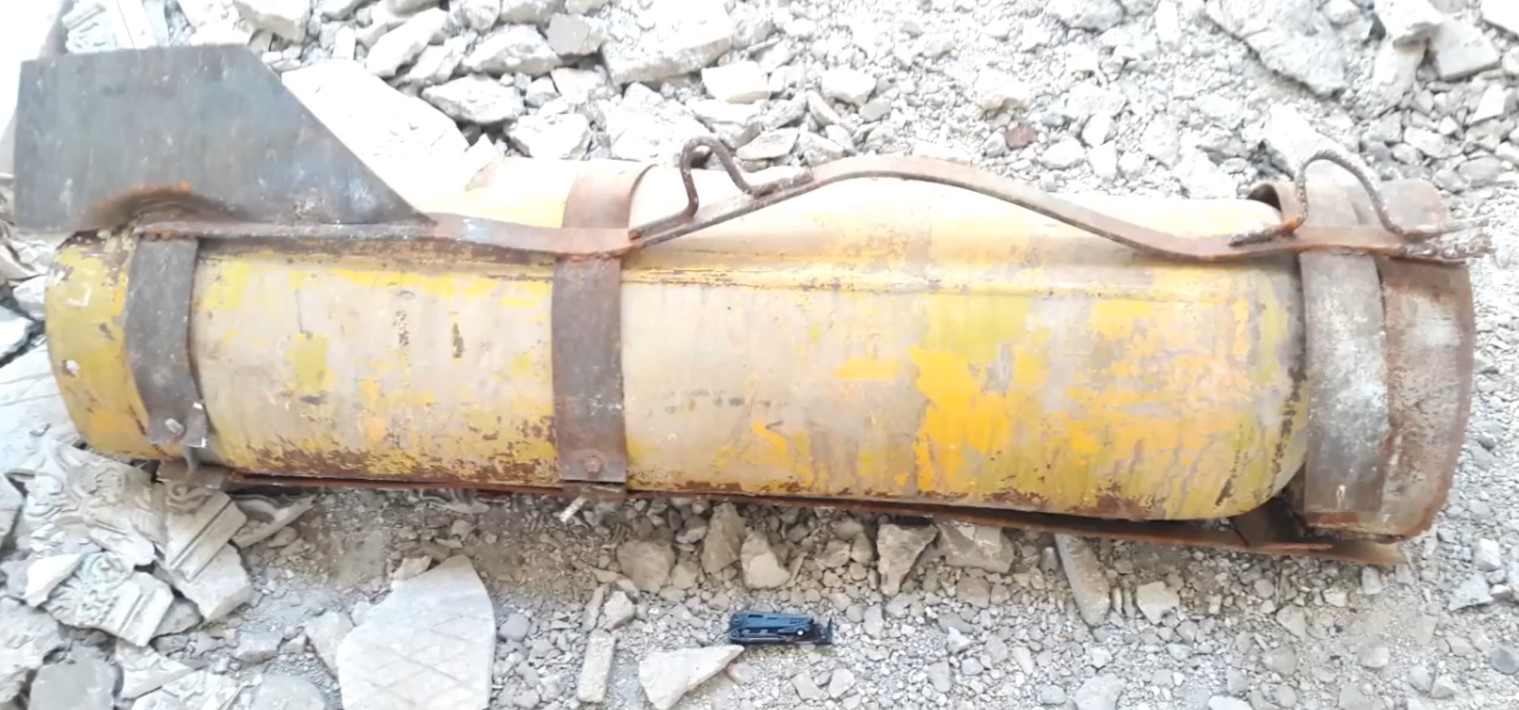
Pro-government forces air dropped chlorine munition (source)
As can been seen, these munitions have all been modified to carry a larger payload, with the exception of the single canister chlorine munition, which is simply dropped from a helicopter and already carries a large amount of chlorine. These larger payloads are required as chlorine dissipates relatively quickly, especially in the open air.
We have never seen a 120mm mortar munition that has been modified to carry chlorine, and it is unlikely a munition of that size would be able to carry enough chlorine to have much effect on target. If this kind of munition were to be modified to carry useable quantities of chlorine it would likely severely limit the explosive payload. A large explosive payload would also destroy chemical agent the munition is loaded with, so a smaller bursting charge would be preferable in an effective chemical munition. It would also limit the range of the mortar bomb, which for a soviet-bloc 120mm mortar is about 5-7 km. This is significant as the distance between the launch site at al-Buraykat and the location visited by the Russian CBRN team is approximately 6,900 meters, which is already near the limit of most 120mm mortar systems used in Syria.
The images posted by SANA and the videos of the Russian CBRN team show fragmentation damage, craters and mortar bomb stems. Assuming these are the remains of the munitions used in the attack, and based on previous examples of munitions used to disperse chlorine in the Syrian conflict, we would expect to see more remnants of the munitions, and less damage caused.
Footage published by various Russian news agencies show the Russian CBRN team collecting samples from the site. It appears the news agencies are all sharing the same source footage, but using different sections of the footage, so no single video shows all the footage together. The following video shows most of the sample collection footage in HD:
https://www.youtube.com/watch?v=MmIdiuSeCR4
Based on the published footage it appears a few pieces of metal debris were recovered from the crater, along with one mortar stem, consistent with a 120mm mortar. Air samples appear to be also collected, but there is no imagery showing other environmental samples, such as soil or plant material, being collected by the Russian CBRN team. This is not to say the Russian CBRN did not collect these samples, only that the footage available of the Russian CBRN at work does not show them collecting these samples.
Footage published on November 27 2018 by Russia’s Zvezda TV News show a Russian mobile laboratory testing samples:
https://www.youtube.com/watch?v=QUk9I1Roy4E
Samples tested in the laboratory include what appear to be soil samples, and a piece of metal consistent in shape with a piece of metal collected by the Russian CBRN team. In the footage of the CBRN team at the site the piece of metal is seen inside a transparent plastic bag sealed with a yellow tag. In the footage from the mobile laboratory a transparent plastic bag sealed with a yellow tag is seen being opened by the person performing the tests, so it is extremely likely this is the same bag show in the earlier footage. In the video of the samples being tested it is stated that they brought soil samples and munition remains they collected immediately after the attack, and that these were improvised 120mm chemical agent filled munitions.
Past use of chemical weapons
It should be noted that previous OPCW investigations have never identified opposition groups other than the Islamic State as having used chemical weapons. The Syrian government has been identified as having used both Sarin and chlorine in 23 separate incidents, and other investigations have indicated they may have used chemical weapons over one hundred times.
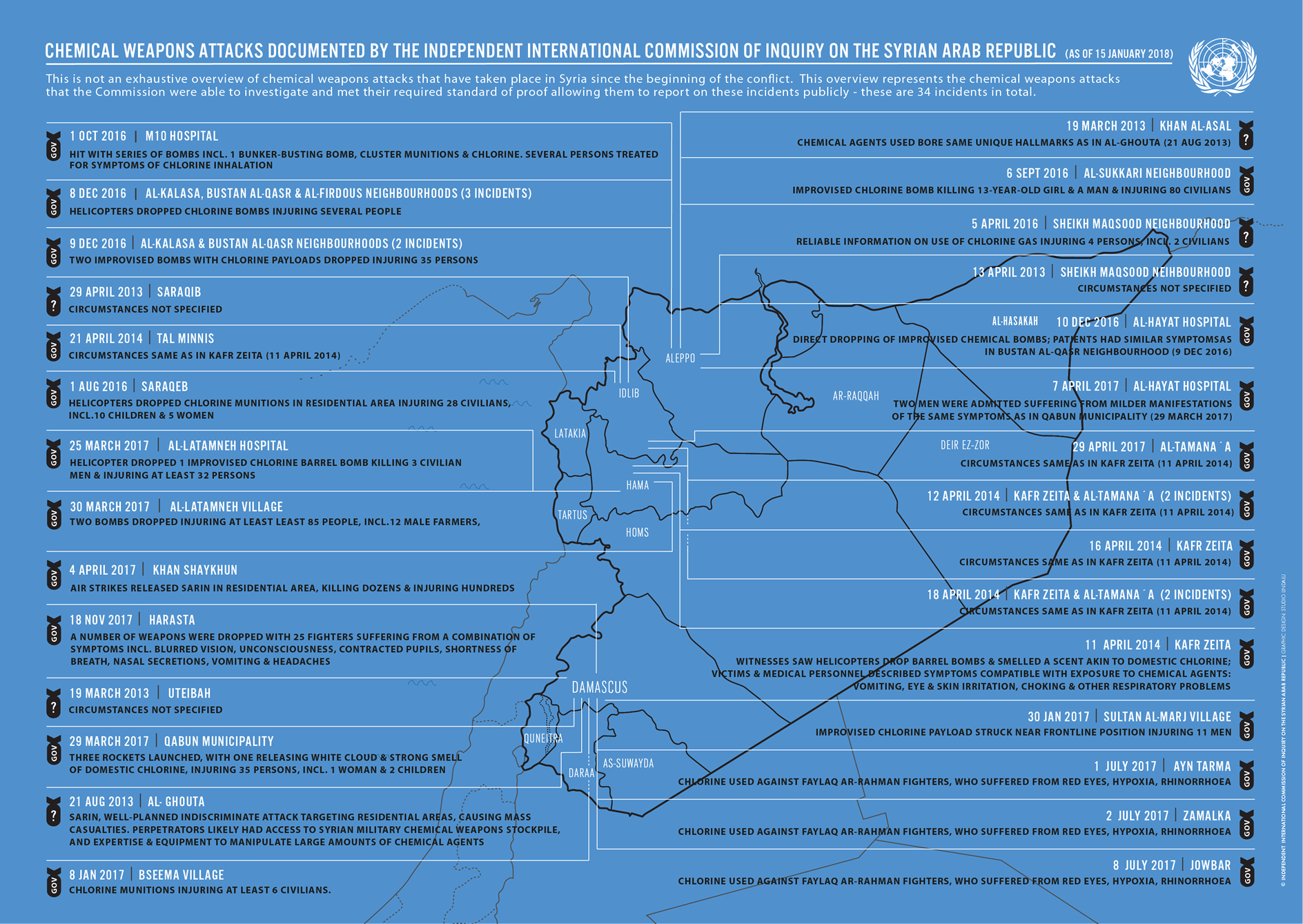
Chemical Warfare incidents investigated by the UN Commission of Inquiry on Syria (source)
Interestingly, both Aleppo University Hospital and al Razi Hospital have previously dealt with a situation which was believed at the time to be a chemical attack. In late 2016 around 60 SAA soldiers were affected by what was, according the OPCW Fact Finding Mission (FFM) to Syria, a non-specified “non-persistent, irritating substance” in the vicinity of Al-Hamadaniyah.
Aleppo University Hospital, al Razi Hospital and Aleppo Military Hospital all had to deal with casualties from this event, and treated them by giving “oxygen, bronchodilators, intravenous (IV) fluids, steroids and broad-spectrum antibiotics”. This appears to be consistent with treatments seen at al Razi and the University Hospital during the recent event. However, the OPCW report also notes that at al Razi Hospital and the Military Hospital the casualties were washed and stripped, which is the recommended action when a person comes into contact with Sarin. This does not appear to have happened in the recent event.
Alleged Inconsistencies
It has been noted by some commentators that there appear to be inconsistencies with the behaviour of the patients. Although some of the behaviour certainly seems strange, it should be noted that in stressful situations people will often do things that do not make sense to an external observers. For example, the OPCW-UN JIM noted that a man was seen in footage of the Khan Sheikhoun Sarin attack conducting CPR on a body which was face-down. This poor medical practice did not detract from the fact that the OPCW-UN JIM concluded that the Syrian government had indeed used Sarin in that attack.
Similarly, although dust masks would not have much effect against a chemical warfare agent, the fact that the doctors and visitors in the hospital are wearing them does not call into question the validity of the footage. Identical accusations have been levelled at the Syrian Civil Defence after Khan Sheikhoun, despite several of them being injured by Sarin as part of the rescue effort. There are many reasons why organisations in Syria may not have proper equipment.
Witness Testimony
Witness testimony in the hospital has been generally consistent on the effects on and the effects and events of the attack.
One man, whose son is seen coughing and almost vomiting in multiple clips, was consistent in his description of the attacks in two seperate videos. In one interview he mentioned that he was unsure what the substance used was, but it felt like he was under the effect of an extremely strong pepper. In a separate interview with Kinane Allouche, a pro-government journalist, he discussed the possibility of it being a chemical weapon or tear gas.
In another interview, a woman with breathing difficulties stated that they heard the strikes come in and then she started to have trouble breathing.
Russian broadcaster Ren.TV interviewed two victims of the attack. One stated she had come into the hospital two hours ago, and after feeling better she returned home. Her daughter’s conditions worsened when she returned home and they then went back to the hospital to treat her.
The second man interviewed says that two hours after he heard a shell hit the area his brother began to feel sick.
Both were interviewed separately and indicated that some of the effects may have been delayed. This differed from any of the other accounts given by victims to state media who described immediate coughing, tearing eyes, and a foul smell.
Conclusion
Current open source information indicates that some kind of event took place in north-west Aleppo city on the evening of the November 24 2018 which resulted in 50-100 people reporting respiratory symptoms. Multiple witnesses appear to agree that some kind of attack took place which resulted in these symptoms. Apart from washing the casualties, the treatments given in open source media appears consistent with previous reactions by hospitals in Aleppo to a suspected chemical weapon attack. Apparent oddities in the symptoms of the patients should be assessed by an impartial doctor before any conclusions are reached.
Fragments consistent with 120mm mortar bombs were found at the scene of the alleged attack, however this would be a very unusual weapon to deliver chlorine, and any 120mm mortar would be at the limit of its range if the “al-Buraykat” we have identified is indeed the launch site.
Above all, a thorough investigation should take place by the OPCW in order to establish the facts of the case, and if possible, assign responsibility for the attack.
Bellingcat’s research for this publication was supported by PAX for Peace.
